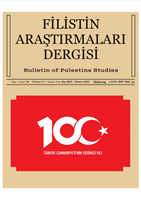Kudüs Millet Bahçesi: Kutsal Şehirde Modernite ve Kentsel Mekân (1870-1917)
Jerusalem Municipal Garden: Urban Space and Modernity in the Holy City (1870-1917)
Author(s): Yasemin Avci, Mihriban UçarSubject(s): Cultural history, Social history, Sociology of Culture, 19th Century, Pre-WW I & WW I (1900 -1919)
Published by: Muhammed Mustafa KULU
Keywords: Jerusalem Municipal Garden; Jaffa Gate; Ottoman Urbanism; the Period of New Order; Public Space;
Summary/Abstract: The concept of "public garden", which we often hear today, has been firstly used in the second half of the 19th century. These parks, which were called "national garden," "urban garden" or "municipal garden", were a new type of public space that had never been seen before in the Ottoman cities. Parks constructed in European style in accordance with pre-prepared plans not only symbolize Tanzimat modernity, but also were significant in examining the Ottoman administrative interventions in urban space. Taksim Garden and Tepebaşı Garden, constructed in 1860s, were the first models of this urban space produced in Istanbul. As it is true of many other urban planning practices of Tanzimat era, Istanbul served as a model for provincial cities, and soon similar places created in other cities. One of these, the municipal garden of Jerusalem, was constructed very close to the Jaffa Gate in 1891, the flourishing urban center since 1860s. It was not only a recreational place where urban inhibitors visited daily to benefit from the open-air, but also it was a place of attraction where theater performances were held, meetings took place in the coffee house inside, and where European daily life practices were experienced by the Jerusalemites. Twice a week, the military band played the Ottoman anthems there thus bringing together people from the various communities in the city. Especially after the Second Constitution Especially during the Second Constitutional Era, the municipal garden also became the venue for political demonstrations. In this paper, the " Jerusalem Municipal Garden" will be examined as a case study of how a new public space appeared in the Ottoman cities in the late 19th century. Following the analysis of its construction process, its place in the daily life of the urban inhibitors, and its spatial relationship with the surrounding region, and how the political agenda was reflected there as a place in which state-society encounters took place, is to be discussed. The main sources of the study are the Ottoman and British archival documents, the photographs and urban plans of the subjected period as well.
Journal: FİLİSTİN ARAŞTIRMALARI DERGİSİ
- Issue Year: 2023
- Issue No: 14
- Page Range: 1-42
- Page Count: 43
- Language: Turkish

